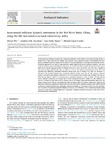Mostrar o rexistro simple do ítem
Intra-annual sediment dynamic assessment in the Wei River Basin, China, using the AIC functional-structural connectivity index
| dc.contributor.author | Wu, Zhenni | |
| dc.contributor.author | Baartman, Jantiene | |
| dc.contributor.author | Nunes, Joao Pedro | |
| dc.contributor.author | López-Vicente, Manuel | |
| dc.date.accessioned | 2023-03-22T17:23:06Z | |
| dc.date.available | 2023-03-22T17:23:06Z | |
| dc.date.issued | 2023 | |
| dc.identifier.citation | Wu, Z., Baartman, J. E., Nunes, J. P., López-Vicente, M. (2023). Intra-annual sediment dynamic assessment in the Wei River Basin, China, using the AIC functional-structural connectivity index. Ecological Indicators, 146, 109775. https://doi.org/10.1016/j.ecolind.2022.109775 | es_ES |
| dc.identifier.uri | http://hdl.handle.net/2183/32746 | |
| dc.description.abstract | [Abstract:] Hydrological and sediment dynamics have changed considerably on the Chinese Loess Plateau during the last six decades due to large scale land use changes and numerous water regulation actions. Understanding the mechanism of sediment transport change and its effects is of great importance to food and environmental security. Numerical approaches are useful to map and assess spatio-temporal patterns in sediment dynamics. This study evaluates monthly and annual sediment connectivity in the Wei River Basin (134,800 km2) at the basin and sub-basin scales using the aggregated index of sediment connectivity (AIC). For the first time, this index is applied on this relatively large regional scale. The two objectives were to (1) evaluate the performance of the AIC at the regional scale, addressing substantial differences among areas, and (2) analyze how each AIC sub-factor co-determines the monthly sediment and connectivity patterns. Results show that AIC has strong or moderate positive correlation with sediment yield from 15 out of 23 stations in the Wei and Jing sub-basin. The Jing sub-basin has the highest sediment connectivity due to degraded vegetation, while the Beiluo sub-basin has the lowest sediment connectivity on average due to better ecological restoration. Within the year, sediment connectivity is highest in April and lowest in January, due to the rainfall regime and intra-annual land cover variations. Among the AIC factors, the rainfall factor has the highest effect on sediment connectivity, implying that functional connectivity (graded by rainfall and soil cover) determines sediment dynamics more than structural connectivity (mainly determined by topography and soil permeability). This study provides one of the first large-scale estimates of spatial and temporal sediment connectivity from hillslopes to river stream and including large reservoirs, which can be further employed to implement regional ecological construction works and environmental catchment management. | es_ES |
| dc.description.sponsorship | China Scholarship Council; 201906300050 | es_ES |
| dc.language.iso | eng | es_ES |
| dc.publisher | Elsevier | es_ES |
| dc.relation.uri | https://doi.org/10.1016/j.ecolind.2022.109775 | es_ES |
| dc.rights | Atribución 3.0 España | es_ES |
| dc.rights.uri | http://creativecommons.org/licenses/by/3.0/es/ | * |
| dc.subject | Sediment connectivity | es_ES |
| dc.subject | Aggregated index of connectivity | es_ES |
| dc.subject | Structural and functional | es_ES |
| dc.subject | Soil erosion | es_ES |
| dc.subject | Loess Plateau | es_ES |
| dc.title | Intra-annual sediment dynamic assessment in the Wei River Basin, China, using the AIC functional-structural connectivity index | es_ES |
| dc.type | info:eu-repo/semantics/article | es_ES |
| dc.rights.access | info:eu-repo/semantics/openAccess | es_ES |
| UDC.journalTitle | Ecological Indicators | es_ES |
| UDC.volume | 146 | es_ES |
| UDC.startPage | 109775 | es_ES |
| dc.identifier.doi | 10.1016/j.ecolind.2022.109775 |






